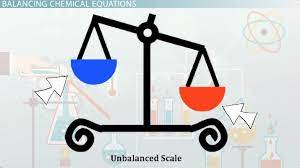A chemical equation is a symbolic representation of a chemical reaction in which the reactants and products are denoted by their respective chemical formulae. So, balancing chemical equations involves the addition of stoichiometric coefficients to the reactants and products.
In this article we would be looking at looking Education Balancing Chemical Equations with 20 Examples

Chemical equations of reactions are also categorized into two types: molecular and ionic equations.
Molecular equations show the molecular formulae of compounds or molecules of elements of all reactants and products. They do not indicate the actual particles interacting and those not interacting. Example are NaCl (aq) + AgNO3 (aq) -> AgCl (s) + NaNO3 (aq)
In ionic equations, water soluble reactants and products are split into their constituent ions while non-ionizing or gaseous reactants and products are represented as formulae or molecules. Hence, the molecular reaction can be written as:
H+ (aq) + Cl– (aq) + Na+ + OH– -> Na+ (aq) + Cl– (aq) + H2O (l)
The net ionic equation is
H+ (aq) + OH– (aq) -> H2O (l)
What is Balanced Chemical Equation
A balanced chemical equation is one in which the Law of conservation of matter is obeyed. The law states that matter is neither created nor destroyed in the course of chemical action. This implies that the total mass of the products of a reaction is exactly equal to the mass of the reacting substances.
In balancing a chemical equation, therefore, there is a conservation of all kinds of atoms involved in the reaction being represented by the equation. Hence, every atom on the left side is accounted for on the right side of the equation. To do this, appropriate numbers called coefficients, are put in front of the formulae.
It should be noted, however, that the subscripts in any of the formulae must not be changed, in an attempt to balance an equation.
Methods of Balancing Chemical Equations
The following methods are among the important ones available for balancing chemical equations:
Trial and Error Method: This method is good for balancing simple equations. It involves putting appropriate coefficients in front of the formula of reactants and/or product(s) so as to achieve the conservation of all atoms.
Examples are:
- H2 + O2 -> H2O (Unbalanced)
- 2H2 + 02 -> 2H2O (balanced)
- KClO3 -> KCl + O2 (unbalanced)
- KClO3 -> 2KCl + 3O2 (balanced)
Mathematical Method: It is good for equations that cannot be easily balanced by inspection. The method involves setting up a simple algebraic equation for each kind of atoms or groups taking part in a reaction so as to achieve the conservation of all atoms or groups.
Example: Using the mathematical method balance the equation KClO3 -> KCl + O2
Let the balanced equation be
aKClO3 -> bKCl + cO2
a, b, and c are the coefficient will have to find.
For K to be conserved, a = b
For Cl to be conserved, a = b
For O to be conserved, 3a = 2c
If a = 1, then b = 1
Since 3a = 2c, 3(1) = 2c,
3 = 2c
C = 3/2
The balanced equation becomes:
KClO3 -> KCl + 3/2 O2
Multiplying the coefficients through by 2 give whole numbers, the balanced equation becomes:
KClO3 -> 2KCl + 3O2
Steps to Balancing Chemical Equations
- Write the unbalanced equation to show the reactants and products.
- Write down how many atoms of each element there are on each side of the reaction arrow.
- Add coefficients (the numbers in front of the formulas) so the number of atoms of each element is the same on both sides of the equation. It’s easiest to balance the hydrogen and oxygen atoms last.
- Indicate the state of matter of the reactants and products and check your work.
20 Balanced Chemical Equations
2Na (s) + 2H20 (l) -> 2NaOH (aq) + H2 (g)
Zn(s) + H2SO4 (aq) -> ZnSO4 (aq) + H2 (g)
CaC2 (s) + 2H2O (l) -> C2H2 (g) + Ca(OH)2 (aq)
2N0 (g) + O2 (g) -> 2NO2 (g)
Mg (s) + 2H2O (l) -> Mg(OH)2 (aq) + H2 (g)
3Fe (s) + 4 H2O (g) -> Fe3O4 (g) + 4H2 (g)
CH4 (g) + H2O (g) -> CO (g) + 3H2 (g)
CUO (s) + H2 (g) -> CU (s) + H20 (l)
3H2 (g) + N2 (g) -> 2NH3 (g)
Pb (s) + 4Na (s) + 4C2H5Cl (g) -> 4NaCl (s) + Pb(C2H5)4 (l)
TiCl4 (l) + 4Na (s) -> 4NaCl (s) + Ti (s)
2NaOH (aq) + CO2 (g) -> Na2CO3 (aq) + H2O (l)
Cl2 (g) + 6NaOH (aq) -> NaClO3 (aq) + 5NaCl (aq) + 3H2O (l) (for concentrated aqueous NaOH)
Na2SO4 (s) + SiO2 (s) -> NaSiO3 (s) + SO3 (g)
Na2SO4 (s) + 4C (s) -> Na2S(s) + 4CO (g)
NaCl (aq) + NH4OH (aq) + CO2 (g) -> NaHCO3 (s) + NH4Cl (aq)
2NaHCO3 (s) -> Na2CO3 (s) + H2O + CO2 (g)
Na2CO3 (s) + 10H2O -> Na2CO3.10H20 (s)
Na2CO3 (aq) + Ca(OH)2 (aq) -> 2NaOH (aq) + CaCO3 (s)
Fe2O3 (s) + 3C (s) -> 2Fe (s) + 3Co (g)
2Cu(NO3)2 (s) -> 2CUO (s) + 4NO2 (g) + O2 (g)
2Al (s) + 6HCl (aq) -> 2AlCl3 (aq) + 3H2 (g)
2Al (s) + 2NaOH (aq) + 6H2O (l) -> 2NaAl(OH)4 (aq) + 3H2 (g)
I hope you find this article helpful as well as interesting.

